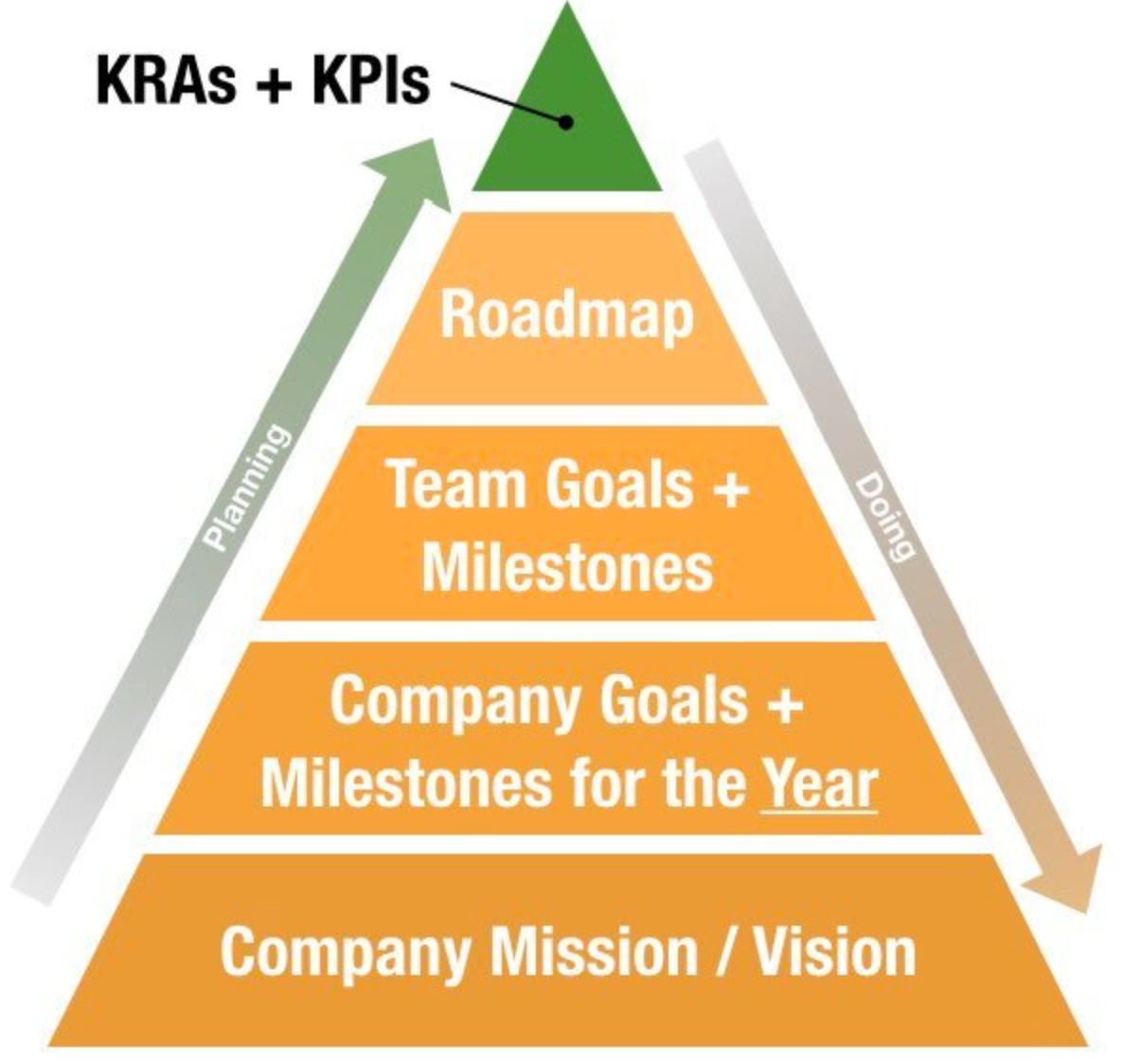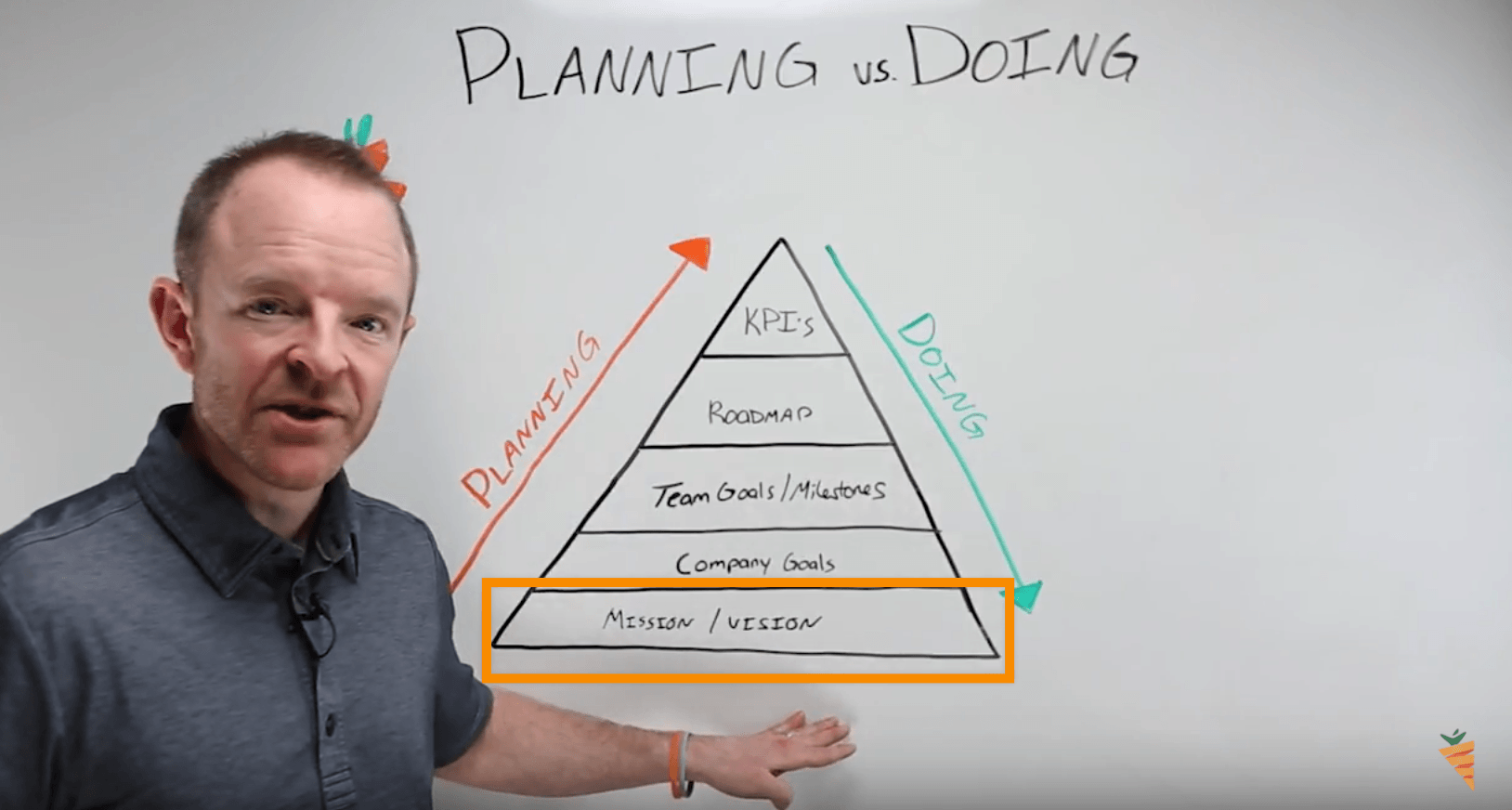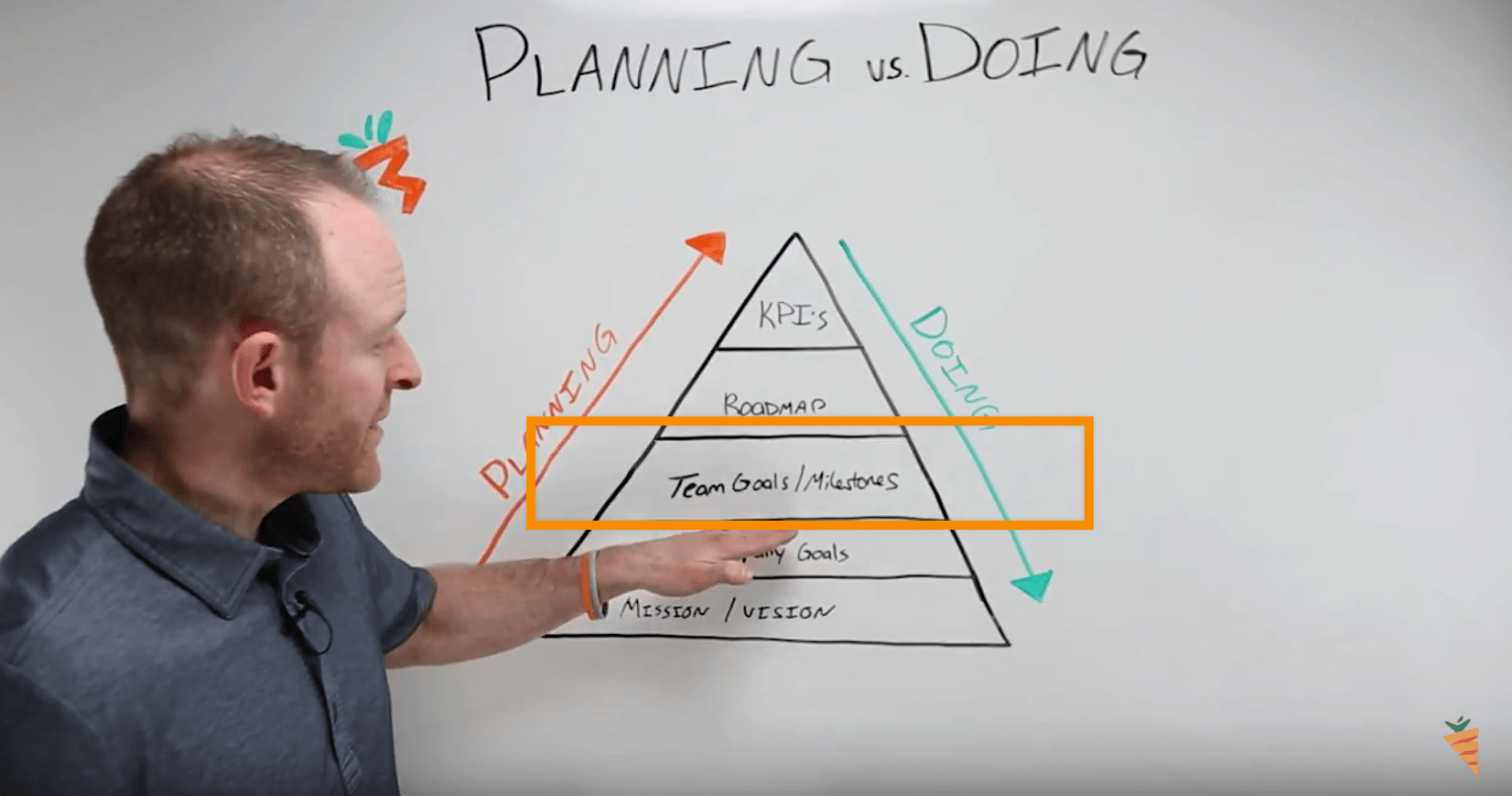Video Transcript
One thing we’ve all got to figure out as entrepreneurs is how to actually get things done. How do we actually get the right things done in the business?
So we’re actually moving forward towards the goals, towards that vision because when we get wrapped into a business into the day-to-day, it’s really easy to get caught in the day to day and the things that are mundane and the things that are boring.
Just the day to day tasks that may or may not be moving the business forward toward your goals.
Planning Versus Doing
So I’m going to walk you through actually a process we’ve created here at Carrot because we ran into the same issues where we would get into the year and we would be going “Shoot, are we doing the right things?
Are the actions we’re doing today actually pushing us towards our goals? Pushing us towards our vision? Do we even know if we’re planning correctly?”

Planning
So over the years, we built this framework. I going to walk you through this framework, kind of behind the scenes stuff here at Carrot on what we do to make sure we’re all going towards the same thing, but also how do you do planning versus doing?
Okay, so the first thing we want to start with is mission and vision. Now, this isn’t anything new, right?
You’ve heard the phrase mission and you have the heard the phrase vision. None of that’s new.
It’s actually often times kind of over said, and sometimes people overlook it because they go “Oh my Gosh, that’s boring. I don’t need that. I just want to get to action doing things.”
But the reason that this is at the foundation is, that, there’s no way we can be doing the right things if we don’t actually know where we’re going. So we have to sit back and go “Where do I want to go in life? Where do I want to go in the business?” Write those down.
Vision Story
The way that we do this is we wrote a vision story, and we just really sat there and actually wrote a story about the business, about our lives.
For the next five years, what is this business going to look like? What is it going to look like product wise, people wise? What mission are we going after? What impact do we want to make? All those types of things. Just sit down and write a story, and it might be two pages, it might be twenty pages. So write that story.
Where are you going? That’s something your whole team needs to be a part of making. Maybe you sit down and write it at the start and share it with the team, get their feedback. That’s the way that we did it.
We shared it with the team and said “Hey, what are you excited about? What do you think needs to be more clear? What did we miss?” And they added stuff to it. They made our vision even stronger.

Mission
And then the mission part of it, which a lot of people get kind of confused is, this is where we’re going, but this is kind of what are we doing on the way there?
What are we trying to impact? What do you want your business to actually impact? It can’t be just money in your pocket, it can’t be just something like that. It’s got to be something to excite you over the long term about “Man, what do I want this business to really impact and do?”
So once you’ve got the foundation set, and make it simple for yourself. Just write the vision story.
Goals
The next thing you want to do is write some basic goals. So what do you want the business to do this next year? What do you want that business to do the next five years?
If we’re talking about just planning for this next year, what are your company goals for this year? Write those top-line goals down. If it’s as a real estate investor or agent, it could be how many deals you want to do.
It could be how much revenue you want to have. Whatever it is, write those goals down at a company level now.

Next, when you have a company with multiple people you need to kind of start breaking it down into different parts of the company. So here at Carrot, we have a couple of dozen employees almost, and we have different parts of the team where we need to set goals there.
Like, what are our marketing and growth goals? What are our goals around our product? What are our goals on our customer success side of things? And that way the team goes away then and comes up with their own goals that all feed into the company goals, that all feed into the vision.
So these all cascade down.
These goals help you achieve the company goals for helping you achieve the mission and vision.
And then it goes into again, once you have your goals nailed, how do I actually get those goals done? What do we need to do first? Are there projects we’ve got to do? Are there initiatives where we need to hire people?
This comes into … this is the rubber meets the road. This is where we actually get the work done this year. So we set our mission and vision. This is where we’re going.
That’s your story.
That’s what gets you excited.
That’s what gets your team members excited to join you because people want to join somewhere … they want to join a company or a movement where it’s going somewhere.
They want to go somewhere with you. They don’t want to just be going and sitting in place in a business or in a movement.
Roadmap
So where are you going? What are our goals on the way there? What things do we have to do to knock off on our way there? What are the actual things that we’ve got to do project wise on our roadmap? Put them on the roadmap.
These are things we need to break down by quarter and go “Okay, this quarter these are our roadmap items. These are the projects we’ve got to do, these are the people we have to hire.”
KPI’s
Things like that. And then from there on the day to day, are your KPIs. That’s your key performance indicators, so how do you actually track to make sure that you’re on task, on pace with those roadmap items? How do you actually know if you’re reaching those goals?
How do you actually know if you’re actually on pace to hit those things?
Well, that’s your KPI.
So what we do is on a weekly basis, what are those things that are the most important that measure whether you’re on pace? For us, let’s say the growth side of things, it might be how many leads did we get this week?
For you guys, it might be how many leads did we get? How many offers did we make? How many people did we meet? Things like that.
So what are those KPIs? Now, when we started rolling this out to the team, we got the foundation, then it builds up to this pinnacle of this is what you’re doing on the day-to-day. This is planning stuff, this is day to day how you track it.
But for the team, it made a lot of sense when we kind of put these lines into it. It said “Planning goes this way.” Planning always goes this way. When you’re sitting ready to plan for the year, your planning always needs to start here.
You need to review that vision. You need to get excited about it. You need to adjust it, work with your team on it.
You need to set goals. Then you need to come up with milestones on the way to those goals or split it up between team goals if you have a big team.
And then you need to go “Okay, to reach those goals, what projects do we have to do?”
That becomes your roadmap. And then we go “Okay, how do we track to make sure we’re on pace with that?” So your planning always goes this way.
Doing
The funny thing is, doing, once you get into the year, it goes the other way. Doing starts here at KPIs and it goes “Okay, are we doing the right things? Let’s look at the KPIs and see if we’re actually doing the right things. Okay, what are the projects we ought to do? Are they leading into these goals? Are they feeding into our vision?”
And those are the things you’ve always got to look at there. So as you’re going in to plan this next year, look at these in this order when you’re planning.
- Vision
- Company goals,
- Team goals and milestones,
- Roadmap
- KPIs.
When you’re actually doing, flip it around. KPIs should cascade all the way down into the vision that you’re going for.
So take this … we actually have a page up. We’re going to link below this video the actual page with this document. Take the document, print it out, go use it with your team and report back.
Download Your Dreams Now Worksheet
On the call, I walk you through how to fill out this worksheet.
We want to hear the success stories. If this helped you kind of clarify your planning process, we have a lot more resources that go with this. Just click the link below this video or this blog post. It takes you to that resource, and share it up. Share it up if this helped you.
And also, go to our Carrot YouTube Channel if you’re not on YouTube right now. Go to YouTube, find our channel and subscribe. Just click subscribe wherever it is. It’s going to be on this page over here.
Subscribe to our channel and you get first access to any content we put out. And also we put out some contests every now and then that is only published on our podcast channel and our YouTube channel.
You can check out our CarrotCast podcast on iTunes. It’s the CarrotCast. Go to carrotcast.com to find that. Have an amazing rest of the week.
Get your planning on for the year and make sure you’re doing the right activities to reach your vision.


I love setting myself goals and achieving them. I have always been a good planner, but to date use pen and paper a lot more than computer devices for my planning!